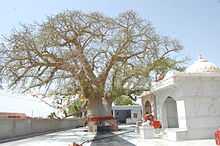Kalpavriksha

Kalpataru, the divine tree of life being guarded by mythical creatures
Kinnara and Kinnari, flying
Apsara and
Devata. 8th century
Pawon temple,
Java, Indonesia.
Kalpavriksha (Devanagari: कल्पवृक्ष), also known as kalpataru, kalpadruma or kalpapādapa, is a wish-fulfilling divine tree in Hindu mythology. It was mentioned in Sanskrit literature from the earliest sources onwards. Sage Durvasa meditated under the Kalpavriksha. Shiva's daughter Ashok Sundari was created from Kalpavriksha tree by Parvati, to alleviate her loneliness.
The kalpavriksha originated during the Samudra manthan or "churning of the ocean of milk" along with the kamadhenu, the divine cow providing for all needs. The king of the gods, Indra, returned with this tree to his paradise.
A kalpavriksha is mentioned in the Sanskrit work Mānāsara as a royal emblem. In Hemādri's work Caturvargacīntama, the kalpavriksha is said to be a tree of gold and precious stones.[1]
Identification with other trees
Other trees are also referred to as the Kalpavriksha.
- At Mangaliyawas near Ajmer, Rajasthan, two revered trees (Male and Female) are more than 800 years old. Known as kalpavrikshas, they are worshipped on an Amavasya day in the Hindu month of Shravan.

Kalpavriksha in Mangaliyawas (near
Ajmer, Rajasthan in India)
- There is a kalpavriksha trees (Male and Female) which are more than 1000 years old in Banswara District of Rajasthan.
- There is a famous and very old Klipvriksha tree at Bilara Dist Jodhpur.
- According to the Padma Purana, a unique baobab near Barabanki is the Parijaat tree, Kintoor.
- At Jyotirmath, Badrinath in Uttarakhand, renowned as the residence of Adiguru Shankaracharya, there is a large, ancient mulberry tree known locally as the kalpavriksha. This tree is a Morus tree, or mulberry. Its unique property is that it never loses a single leaf by itself and is evergreen.
- The Banyan tree has been referred to as the kalpavriksha.
- In certain parts of India, especially coastal areas, the coconut tree is referred to as kalpavriksha or kalpataru because of its ability to amply provide for human needs.

KalpVriksh Bilara
See also
References
External links
|
|---|
| | Main topics | |
|---|
| | Rituals | |
|---|
| | |
|---|
| | Mantras | |
|---|
| | Objects | |
|---|
| | Materials | |
|---|
| | Instruments | |
|---|
| | Iconography | |
|---|
| | Places | |
|---|
| | Roles | |
|---|
| | Sacred animals | |
|---|
| | Sacred plants | | Trees | |
|---|
| | Fruits and other plants | |
|---|
|
|---|
| | See also | |
|---|
|


